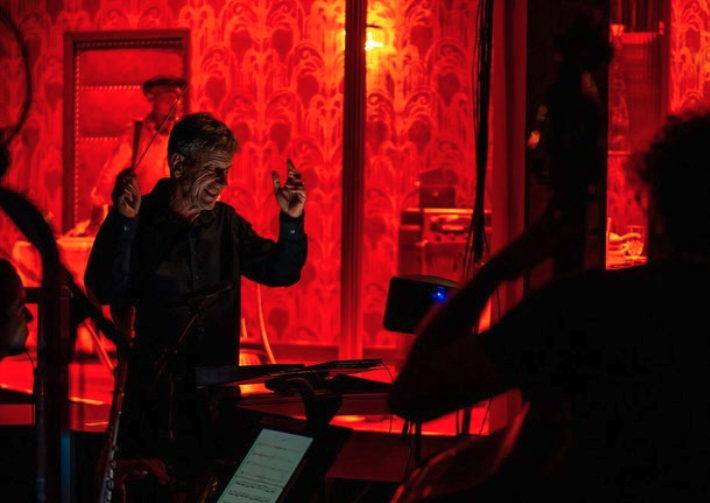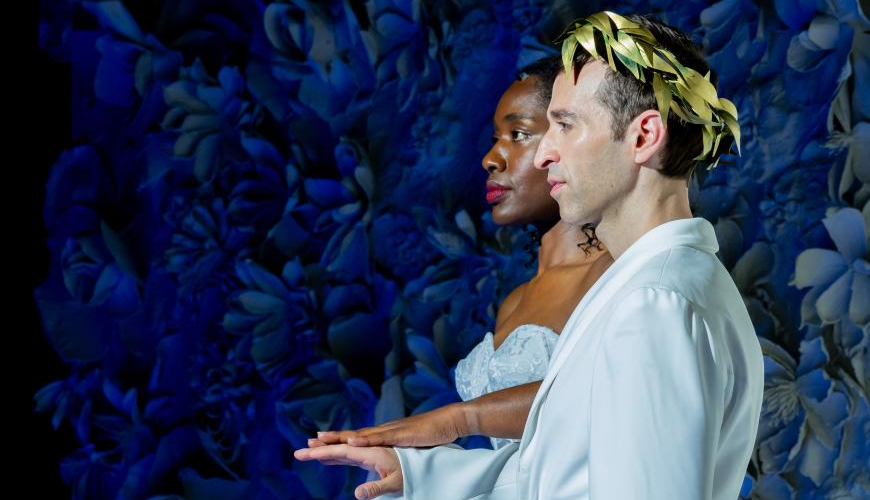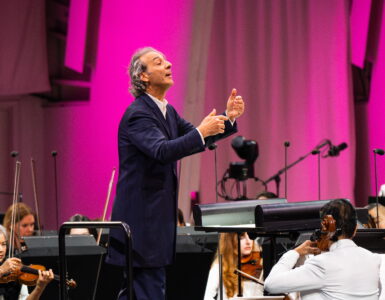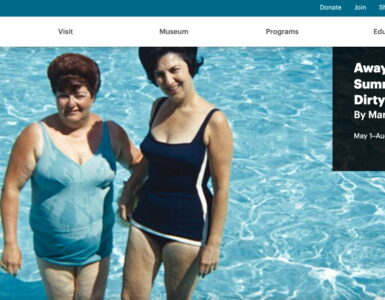
An inspired mash-up between two works, The Comet / Poppea is a new opera from The Industry, conceived by company founder and co-artistic director, Yuval Sharon, and composed by George Lewis, with libretto by poet Douglas Kearney.
Six years in the making, the modern opera is now playing at the WAREHOUSE at Geffen Contemporary at MOCA, in Downtown LA. The Comet / Poppea runs until June 23, 2024.
Above photo: Marc Lowenstein, The Comet / Poppea (2024). Performance documentation from the Geffen Contemporary at MOCA. Image by Austin Richey, courtesy MOCA and The Industry.

Blending historical narrative with contemporary themes, the opera unfolds against the backdrop of cosmic events and human ambition, intertwining the stories of a historical comet with a tale of the infamous Roman empress, Poppea. Directed by Yuval Sharon, with music by George Lewis and libretto by Douglas Kearney, this production aims to push boundaries and redefine the operatic experience.
Claudio Monteverdi’s final opera, “L’Incoronazione di Poppea” (The Coronation of Poppaea) is an Italian opera with libretto by Giovanni Francesco Busenello from 1643 that explores the social divisions of ancient Rome. It describes how Poppaea, mistress of the Roman emperor Nero, is able to achieve her ambition and be crowned empress.
In his short story from 1920 by W.E.B. Du Bois, the famous Black sociologist, The Comet uses tropes of sci-fi catastrophe, to explore race barriers and cultural transformation. This more modern story explores the relationship between Jim Davis (a Black man) and Julia (a wealthy White woman) after a comet hits New York and unleashes toxic gases that seems to have killed everyone in New York City besides them.
Du Bois’ story is located in a swanky, upper-story Fifth Avenue restaurant. Well-dressed corpses are motionless at some of the tables. Grappling with comprehending the crisis around him, Jim (Davóne Tines) samples whatever leftover foods and fine wines he can find. He remarks (several times) that this is a place where he previously would not have been allowed to eat, gloomily intoning “I would not have been served here yesterday.” He listens to Poppea on the restaurant’s radio, hoping for news of the catastrophe in the world outside. Julia (Kiera Duffy), a high society white woman has headed to the restaurant to meet her family there for dinner. She emerges from the elevator seeking answers and shelter. Baffled and mistrustful of each other, eventually Jim shoots off his flares from the roof to signal for any rescuers on the streets below. Julia’s haunting query “Is the world—gone?” is a poignant refrain.
Presented on a turntable divided in two halves, these worlds of the two works unfold simultaneously, with the stage’s rotation creating a visual and sonic spiral for audiences—inviting associations, dissociations, collisions, and confluences.
The audacious staging within MOCA’s long and narrow downtown warehouse has the audience seated on opposite sides, with the two sets positioned on each half of a set atop a large, revolving turntable. As the opera begins, so does the turntable, revolving slowly for the entire 85 minutes of the show, revealing each hemisphere of the set to the audience. Sometimes you can hear the action happening on the other side as you wait for that view to revolve into view. The audibly clunking mechanics only sometimes become present during the quieter moments of the opera.
As the piece goes on, those two works start to leak into each other. Drawing on Du Bois’s own concept of ‘double consciousness,’ the opera is structured around a number of these doublings: points of repetition or intersection that underscore the dialogue between the two works and the relevance of that dialogue today.
Composer George Lewis.
The score of The Comet/Poppea is a masterful fusion of classical opera techniques and modern experimentalism. Composer George Lewis’ use of dissonance and unconventional instrumentation creates an atmosphere that is both haunting and mesmerizing. The vocal arrangements, ranging from lyrical solos to powerful duets, showcase the versatility and skill of the cast. Especially noteworthy are the moments where the composition mirrors the celestial themes, with ethereal sounds and sweeping crescendos evoking the grandeur of cosmic events.
Sound designer Mark Grey uses the Spacemap Go spatial sound design and mixing tool to create audio that follows the circular movement of the set to create a natural feel, while also using distance effects and warping to create a surreal sonic image.

Anthony Roth Costanzo’s performance in The Comet/Poppea exemplifies his status as a leading countertenor of his generation. Capable of an extraordinarily high range, his soaring voice was reminiscent of what I imagine a castrato may have sounded. Through his portrayal of both a historical figure and a mythical persona, Costanzo demonstrates unparalleled vocal prowess, interpretive depth, and emotional resonance. Costanzo’s performance is a testament to his versatility, artistry, and ability to captivate audiences with his vocal and dramatic skills.
The Comet/Poppea as a must-see production for opera aficionadi that showcases the intersection of talent, innovation, and thematic exploration in contemporary opera.
“The last thing he says is, if you ever want a job, ‘call’ — and that is, of course, a totally disingenuous line, as it’s staged,” Costanzo said. “I hand him a tip, a piece of money — basically, you know, exerting my white supremacy. And I sing ‘call’ with that same kind of eerie pianissimo that we hear in Nero’s world. And so I’m trying to find, through vocal colors, the connections rather than the differences.”
Quoted from the New York Times.

The Comet / Poppea
An opera presented by The Industry and Museum of Contemporary Art (MOCA).
Composed by George Lewis
Libretto by Douglas Kearney
Concept & Direction by Yuval Sharon
June 14–23, 2024
WAREHOUSE at Geffen Contemporary at MOCA
The Geffen Contemporary at MOCA
152 North Central Avenue, Los Angeles, CA 90012
Performances:
General Admission: $40.00
MOCA, The Industry,
and AMOC* Members: $35.00
Students: $25.00
Remaining performances dates & times:
June 20, 2024, 5:00 & 8:00pm
June 21, 2024, 5:00 & 8:00pm
June 22, 2024, 2:00 & 8:00pm
June 23, 2024, 2:00pm
PUBLIC PROGRAMS:
The Comet / Poppea in Conversation
Saturday, June 22, 2024 at 2:00 pm
The Industry’s Founder and Co-Artistic Director Yuval Sharon joins curator, writer, and interviewer Paul Holdengräber after the performance to discuss The Comet / Poppea and Sharon’s forthcoming book, A New Philosophy of Opera.
The Comet / Poppea is realized through a landmark partnership among organizations across the United States, produced by Anthony Roth Costanzo and Cath Brittan, The Industry, AMOC* (American Modern Opera Company), Curtis Institute of Music, and Yale Schwarzman Center.
CAST:
The Comet / Poppea features a rotating cast of performers from Los Angeles and New York.
Engagements are subject to change
Lindsay Patterson Abdou (Love / Nellie)
Performing June 16, 2pm; June 20, 5pm; June 21, 8pm; & June 22, 2pm
Cedric Berry ** (Jim / Mercury)
Performing June 15, 8pm; June 20, 5pm; June 21, 8pm; & June 23, 2pm
Amanda Lynn Bottoms (Ottone / Virtue)
Performing All Performances
Anthony Roth Costanzo *** (Nero / Julia’s Father)
Performing June 14, 8pm; June 15, 8pm; June 16, 2pm; June 20, 8pm; June 21, 8pm; June 22, 2pm; June 23, 2pm
Kiera Duffy (Julia)
Performing June 14, 8pm; June 16, 2pm; June 18, 8pm; June 20, 5pm; June 21, 8pm; June 22, 8pm; & June 23, 2pm
James Hayden **(Seneca)
Performing All Performances
Laurel Irene (Julia)
Performing June 15, 8pm; June 20, 8pm; June 21, 5pm; & June 22, 2pm
Eric Jurenas (Nero / Julia’s Father)
Performing June 18, 8pm; June 20, 5pm; June 21, 5pm; & June 22, 8pm
Joanna Lynn-Jacobs (Poppea)
Performing June 16, 2pm; June 20, 8pm; June 21, 5pm; & June 22, 2pm
Joelle Lamarre (Love / Nellie)
Performing June 14, 8pm; June 15, 8pm; June 18, 8pm; June 20, 8pm; June 21, 5pm; June 22, 8pm; & June 23, 2pm
Whitney Morrison (Ottavia / “Friend” / Fortune).
Performing: June 14, 8pm; June 15, 8pm; June 18, 8pm; June 20, 8pm; June 21, 5pm; June 22, 8pm; & June 23, 2pm
Davóne Tines ***(Jim / Mercury)
Performing June 14, 8pm; June 16, 2pm; June 18, 8pm; June 20, 8pm; June 21, 5pm; June 22, 2pm; & June 22, 8pm
Nardus Williams (Poppea)
Performing June 14, 8pm; June 15, 8pm; June 18, 8pm; June 20, 5pm; June 21, 8pm; June 22, 8pm; & June 23, 2pm
Mikaela Elson (Ottone / Virtue, understudy)
Ben Lin (Seneca, understudy)
Instrumentalists:
Doug Balliett*** (Double Bass)
Matt Cook (Percussion)
Gabriel Crist (Harpsichord)
Miranda Cuckson*** (Viola)
Emi Ferguson*** (Flute)
Keir GoGwilt*** (Violin)
Richard Valitutto (Piano)
Coleman Itzkoff*** (Cello)
Eric Tinkerhess (Baroque Cello)
Jason Koji Yoshida (Theorbo)
** The Industry Company Member
*** AMOC* Company Member





